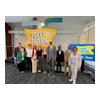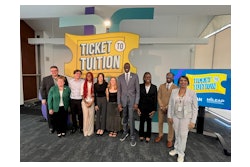The number of U.S. students studying overseas has reached a new record, part of an upward trend that also shows greater diversity both in the study abroad population and the foreign destinations selected for their studies.
More than 40,000 students of color studied abroad in 2006-07, nearly double the number from 2001, based on data from the Institute of International Education. Overall, African Americans, Hispanics, Asian Americans, Native Americans and multiracial students made up nearly one of every five study abroad students in 2007, says the institute’s annual Open Doors report.
Part of this increase is due to increased marketing at minority-serving institutions as well as greater utilization of scholarships, officials said. Students of color now represent about half of all recipients of Gilman Scholarships, a U.S. State Department initiative authorized by Congress in 2000 to improve study abroad participation by Pell Grant recipients.
The U.S. is “aggressively marketing and expanding the diversity of our international student population,” said Goli Ameri, assistant secretary of state for educational and cultural affairs, at a news briefing Monday. African American and Hispanic students also represent about 10 percent of all Fulbright scholars, she said.
“We have ensured our outreach campaigns target the full array of talented potential participants from community colleges and minority-serving institutions to public and private universities and colleges,” she said.
Student destinations also are undergoing some changes, the data show. Although Western Europe is still the most popular area for study, the number selecting South Africa, China, Ecuador, India and Saudi Arabia are among those with the largest increases. In each of these countries, the number of U.S. students surged by more than 20 percent, including a 28 percent increase in South Africa.
Officials credited this trend largely to an expansion in the range of study abroad options. Overall, the number of U.S. students studying in Asia and Africa in 2007 increased by 20 percent and 19 percent, respectively. Aside from new locations, many study abroad programs are shorter than one semester in length, making them a viable option for more students.
While the traditional study abroad program runs a full semester, many new offerings run two to eight weeks, such as January or summer-long programs.
The Open Doors report also showed a surge in the number of foreign students studying at U.S. colleges and universities. An increase of 41,000 students in 2007-08 – a gain of 7 percent – has reversed a slight decline since the Sept. 11, 2001 terrorist attacks, researchers said. As a result, more than 623,000 foreign students studied in the U.S. last year.
“The steady increase in the number of international students in the United States reflects actions taken by the U.S. government and many individual colleges and universities to ensure that international students know they are welcome here,” said Allan Goodman, president of the Institute of International Education.
India had 94,563 students studying in the U.S. last year, the most of any country and about 15 percent of all international students. China followed with 81,127, or about 13 percent of the total.
Others among the top 20 in supplying foreign students to the U.S. included Saudi Arabia, Vietnam, Nigeria and Nepal, some of which had large single-year increases. For example, the number of international students from Vietnam increased by 45 percent in one year, to 8,769, the data showed.
Among U.S. colleges enrolling international students, the University of Southern California had the most with 7,189. The top five also included New York University, Columbia University, the University of Illinois at Urbana-Champaign and Purdue University.
More information on the study is available at https://joker123.inc/.
Email the editor: [email protected]
Click here to post and read comments
© Copyright 2005 by DiverseEducation.com


















